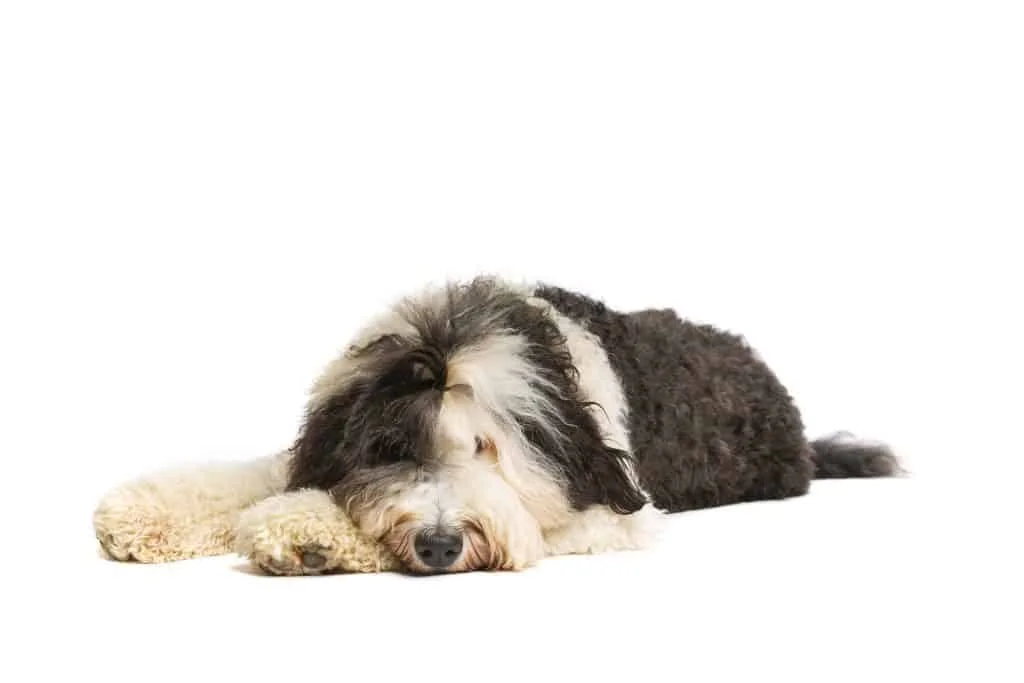Sheepadoodles are beautiful teddy-bear like dogs that everyone loves! They are a hybrid mix of the Poodle and the Old English Sheepdog. Both of these breeds are dogs that get along great with humans, and the Sheepadoodle is no different! Before you get one, however, it is important to examine your living situation and decide if it suits the dog’s needs.
As a general rule, Sheepadoodles do well in apartments that have access to some yard space. It can be a real challenge to make an apartment work for a Sheepadoodle. While smaller generations may learn to live in an apartment, they will still need lots of exercise every day in order to thrive.
If you are considering getting a Sheepadoodle to be your flatmate, you must thoroughly understand their needs and decide if you have the time and the energy to provide for them.
What Are the Different Sizes of Sheepadoodles?
Standard Sheepadoodles are medium to large-sized. In some scenarios, they can even grow up to be massive! However, there are smaller sizes as well.
| Weight | Height | |
| Standard Sheepadoodle | 60 – 80 pounds | 22 – 26 inches |
| Medium Sheepadoodle | 40-60 pounds | 19 – 22 inches |
| Mini Sheepadoodle | 25 – 40 pounds | 15 – 20 inches |
The Standard Sheepadoodle generally does not do very well in an apartment. While these are not the highest-energy dogs, they are still very active, need plenty of regular exercise, and thrive outdoors.
The ideal home for a Standard Sheeppoo is a house with a relatively large yard to run around and play in. Living in an apartment can mean that your dog has very limited space, which can cause them to become agitated and act out by destroying furniture around the house.
The same holds for the Medium Sheepadoodle. As for the Mini, while they may do well in an apartment, they still require lots of exercises.
This means you will have to commit to daily walks, as well as a park or beach visits on the weekends, to keep your dog healthy and happy.
Can a Sheepadoodle Live In an Apartment?
While it is not ideal, you can make the situation work if you are very eager to own a Sheepadoodle and are sure you can commit to their needs. Here are a few things to consider:
Personal Doggy Space
Sheepadoodles love being near their humans, but all dogs should have their personal space. This is also an essential part of training since it teaches your dog to be more independent and prevents separation anxiety.
A designated doggy space means a corner where you can place your dog’s bed, food bowls, and their favorite toys. Consider whether this would be possible in your apartment. While you may be tempted to let your dog sleep in the same space as you, this can lead to an overly attached dog.
In such a case, you may face issues when you have to leave your dog alone to go to work.
Puppy Proof Space
Houses allow pet parents to create puppy-proof spaces, meaning that the dog can freely roam around without causing any problems. In smaller areas, dogs are more likely to knock things over or destroy furniture.
Apartments usually don’t allow for this, but this depends on both your preferences and your training. If you don’t mind your Sheepadoodle on the couch, that’s great!
If not, you can start training your puppy early about which areas and furniture items in the apartment are off-limits.
Your Schedule
Dogs need exercise, especially if they live in an apartment. The Sheepadoodle is no different. Some Sheeppoo owners claim that their dogs are very calm and happy with a quick daily walk, but this is not a common scenario.
You should be prepared to walk your dog multiple times a day. They would also like to go to the park or on a hike now and then.
As a general rule, you can keep a Sheepadoodle in an apartment if you are a very active person who enjoys the outdoor time. If you live alone, working long hours can be a problem. You will need a job with flexible working hours or consistently have a dog sitter on hand.

Can a Sheepadoodle Be Left Alone?
It is possible, but keep in mind that Sheepadoodles are social animals. When left alone for long periods of time without any prior training, they can engage in behaviors like destroying furniture, pooping around the house, or chewing on shoes and other items.
This is due to anxiety and frustration. Your dog can also develop prolonged anxiety, which can cause them to become depressed, change their eating habits, or experience gastrointestinal discomfort.
If you are planning to work full-time and be away for a long period of time every day, it is important to start training your puppy early on. Here are a few ways to do this:
- Don’t overly coddle your puppy when they come home. Engage them with interactive toys and teach them to have fun both with and without you.
- Start leaving your puppy alone for short periods of time, starting with one minute. A general rule is one minute for every month of age.
- Leave the room without saying goodbye or creating a big deal about it. Let your puppy play with their favorite toys during this time. While you may be tempted, don’t make a big deal even when you return.
Your puppy should learn it is normal for you to go and come back. - Invest in interactive toys like treat dispensers and small-range ball launchers if you have the space. This will keep your puppy busy while you are gone. You can also use toys like Kongs to keep them engaged.
In order to make the situation easier for you and your dog, here are a few additional tips:
- Install a puppy cam to see how your dog is doing while you are away.
- Find a way to take a break between your workday and return to take your dog out for a short walk. If you can’t do this, hire a dog sitter to take your place.
Sheepadoodles should not be left alone for 8 hours at a time. - Give your dog at least two walks a day, one before you leave and one after you return.
- Don’t leave them in their crate for long hours. This can cause dogs to become depressed since they may feel like they are being punished.
- Invest in an automatic feeder and ensure there is plenty of water available at all times.
It is important to remember that you can not leave a puppy alone for this long! These tips will work for adult dogs, and puppies need to relieve themselves every two hours.
The process of leaving them alone should be built over time to ensure a healthy and happy relationship with your dog.
